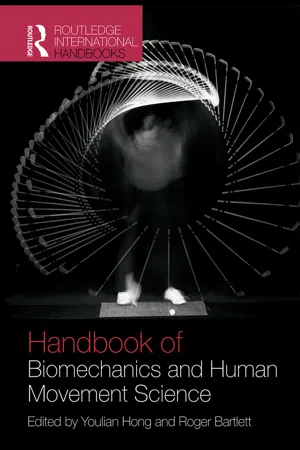
Routledge Handbook of Biomechanics and Human Movement Science
- 610 pages
- English
- ePUB (mobile friendly)
- Available on iOS & Android
Routledge Handbook of Biomechanics and Human Movement Science
About this book
The Routledge Handbook of Biomechanics and Human Movement Science is a landmark work of reference. Now available in a concise paperback edition, it offers a comprehensive and in-depth survey of current theory, research and practice in sports, exercise and clinical biomechanics, in both established and emerging contexts.
Including contributions from many of the world's leading biomechanists, the book is arranged into five thematic sections:
- biomechanics in sports
- injury, orthopedics and rehabilitation
- health and rehabilitation
- training, learning and coaching
- methodologies and systems of measurement.
Drawing explicit connections between the theoretical, investigative and applied components of sports science research, this book is both a definitive subject guide and an important contribution to the contemporary research agenda in biomechanics and human movement science. It is essential reading for all students, scholars and researchers working in sports biomechanics, kinesiology, ergonomics, sports engineering, orthopaedics and physical therapy.
Frequently asked questions
- Essential is ideal for learners and professionals who enjoy exploring a wide range of subjects. Access the Essential Library with 800,000+ trusted titles and best-sellers across business, personal growth, and the humanities. Includes unlimited reading time and Standard Read Aloud voice.
- Complete: Perfect for advanced learners and researchers needing full, unrestricted access. Unlock 1.4M+ books across hundreds of subjects, including academic and specialized titles. The Complete Plan also includes advanced features like Premium Read Aloud and Research Assistant.
Please note we cannot support devices running on iOS 13 and Android 7 or earlier. Learn more about using the app.
Information
Section III Methodologies and systems of measurement
11 Measurement of pressure distribution
Introduction
Sensor technologies
Resistive transducer
Piezoelectric transducers
Table of contents
- Cover Page
- Half Title Page
- Title Page
- Copyright Page
- Table of Contents
- Introduction
- Section I: Modelling and simulation of tissue load
- Section II: Neuromuscular system and motor control
- Section III: Methodologies and systems of measurement
- Section IV: Engineering technology and equipment design
- Section V: Biomechanics in sports
- Section VI: Injury, orthopedics and rehabilitation
- Section VII: Health promotion
- Section VIII: Training, learning and coaching
- Index